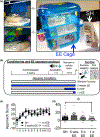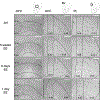Acute, but not longer-term, exposure to environmental enrichment attenuates Pavlovian cue-evoked conditioned approach and Fos expression in the prefrontal cortex in mice
- PMID: 33565633
- PMCID: PMC8085094
- DOI: 10.1111/ejn.15146
Acute, but not longer-term, exposure to environmental enrichment attenuates Pavlovian cue-evoked conditioned approach and Fos expression in the prefrontal cortex in mice
Abstract
Exposure to environmental enrichment can modify the impact of motivationally relevant stimuli. For instance, previous studies in rats have found that even a brief, acute (~1 day), but not chronic, exposure to environmentally enriched (EE) housing attenuates instrumental lever pressing for sucrose-associated cues in a conditioned reinforcement setup. Moreover, acute EE reduces corticoaccumbens activity, as measured by decreases in expression of the neuronal activity marker "Fos." Currently, it is not known whether acute EE also reduces sucrose seeking and corticoaccumbens activity elicited by non-contingent or "forced" exposure to sucrose cues, which more closely resembles cue exposure encountered in daily life. We therefore measured the effects of acute/intermittent (1 day or 6 day of EE prior to test day) versus chronic (EE throughout conditioning lasting until test day) EE on the ability of a Pavlovian sucrose cue to elicit sucrose seeking (conditioned approach) and Fos expression in the medial prefrontal cortex (mPFC), orbitofrontal cortex (OFC), and nucleus accumbens (NAc) in mice. One day, but not 6 day or chronic EE , reduced sucrose seeking and Fos in the deep layers of the dorsal mPFC. By contrast, 1 day, 6 day, and chronic EE all reduced Fos in the shallow layers of the OFC. None of the EE manipulations modulated NAc Fos expression. We reveal how EE reduces behavioral reactivity to sucrose cues by reducing activity in select prefrontal cortical brain areas. Our work further demonstrates the robustness of EE in its ability to modulate various forms of reward-seeking across species.
Keywords: Fos; Pavlovian appetitive conditioning; cue reactivity; environmental enrichment; food seeking; prefrontal cortex.
© 2021 The Authors. European Journal of Neuroscience published by Federation of European Neuroscience Societies and John Wiley & Sons Ltd.
Conflict of interest statement
CONFLICTS OF INTEREST
The authors declare no competing financial interests.
Figures



Similar articles
-
Cortico-Striatal Control over Adaptive Goal-Directed Responding Elicited by Cues Signaling Sucrose Reward or Punishment.J Neurosci. 2022 May 4;42(18):3811-3822. doi: 10.1523/JNEUROSCI.2175-21.2022. Epub 2022 Mar 29. J Neurosci. 2022. PMID: 35351827 Free PMC article.
-
Effects of acute or chronic environmental enrichment on regional Fos protein expression following sucrose cue-reactivity testing in rats.Brain Struct Funct. 2016 Jun;221(5):2817-30. doi: 10.1007/s00429-015-1074-z. Epub 2015 Jun 12. Brain Struct Funct. 2016. PMID: 26068175 Free PMC article.
-
Changes in Appetitive Associative Strength Modulates Nucleus Accumbens, But Not Orbitofrontal Cortex Neuronal Ensemble Excitability.J Neurosci. 2017 Mar 22;37(12):3160-3170. doi: 10.1523/JNEUROSCI.3766-16.2017. Epub 2017 Feb 17. J Neurosci. 2017. PMID: 28213443 Free PMC article.
-
Prelimbic to Accumbens Core Pathway Is Recruited in a Dopamine-Dependent Manner to Drive Cued Reinstatement of Cocaine Seeking.J Neurosci. 2016 Aug 17;36(33):8700-11. doi: 10.1523/JNEUROSCI.1291-15.2016. J Neurosci. 2016. PMID: 27535915 Free PMC article.
-
Environmental enrichment reduces food seeking and taking in rats: A review.Pharmacol Biochem Behav. 2020 Mar;190:172874. doi: 10.1016/j.pbb.2020.172874. Epub 2020 Feb 19. Pharmacol Biochem Behav. 2020. PMID: 32084492 Free PMC article. Review.
Cited by
-
Individual differences in prelimbic neural representation of food and cocaine seeking.Cell Rep. 2024 Dec 24;43(12):115022. doi: 10.1016/j.celrep.2024.115022. Epub 2024 Nov 29. Cell Rep. 2024. PMID: 39607827 Free PMC article.
-
Prelimbic cortical excitatory overdrive and inhibitory underdrive accompany environmental suppression of food seeking.bioRxiv [Preprint]. 2025 May 23:2025.05.21.655312. doi: 10.1101/2025.05.21.655312. bioRxiv. 2025. Update in: Neuropsychopharmacology. 2025 Sep;50(10):1472-1481. doi: 10.1038/s41386-025-02142-y. PMID: 40475591 Free PMC article. Updated. Preprint.
-
Environmental Enrichment Components Required to Reduce Methamphetamine-Induced Behavioral Sensitization in Mice: Examination of Behaviors and Neural Substrates.J Clin Med. 2022 May 28;11(11):3051. doi: 10.3390/jcm11113051. J Clin Med. 2022. PMID: 35683439 Free PMC article.
-
Food seeking suppression by environmental enrichment accompanies cell type- and circuit-specific prelimbic cortical modulation.bioRxiv [Preprint]. 2025 Jun 14:2025.06.11.659116. doi: 10.1101/2025.06.11.659116. bioRxiv. 2025. PMID: 40661548 Free PMC article. Preprint.
-
Prelimbic cortical excitatory overdrive and inhibitory underdrive accompany environmental suppression of food seeking.Neuropsychopharmacology. 2025 Sep;50(10):1472-1481. doi: 10.1038/s41386-025-02142-y. Epub 2025 Jun 6. Neuropsychopharmacology. 2025. PMID: 40473977 Free PMC article.
References
-
- Berendse HW, Galis-de Graaf Y, & Groenewegen HJ (1992). Topographical organization and relationship with ventral striatal compartments of prefrontal corticostriatal projections in the rat. The Journal of Comparative Neurology, 316, 314–347. - PubMed
-
- Black RW (1968). Shifts in magnitude of reward and contrast effects in instrumental and selective learning: A reinterpretation. Psychological review, 75, 114–126. - PubMed
-
- Bolte S, & Cordelières FP (2006). A guided tour into subcellular colocalization analysis in light microscopy. Journal of Microscopy, 224, 213–232. - PubMed
Publication types
MeSH terms
Grants and funding
LinkOut - more resources
Full Text Sources
Other Literature Sources

